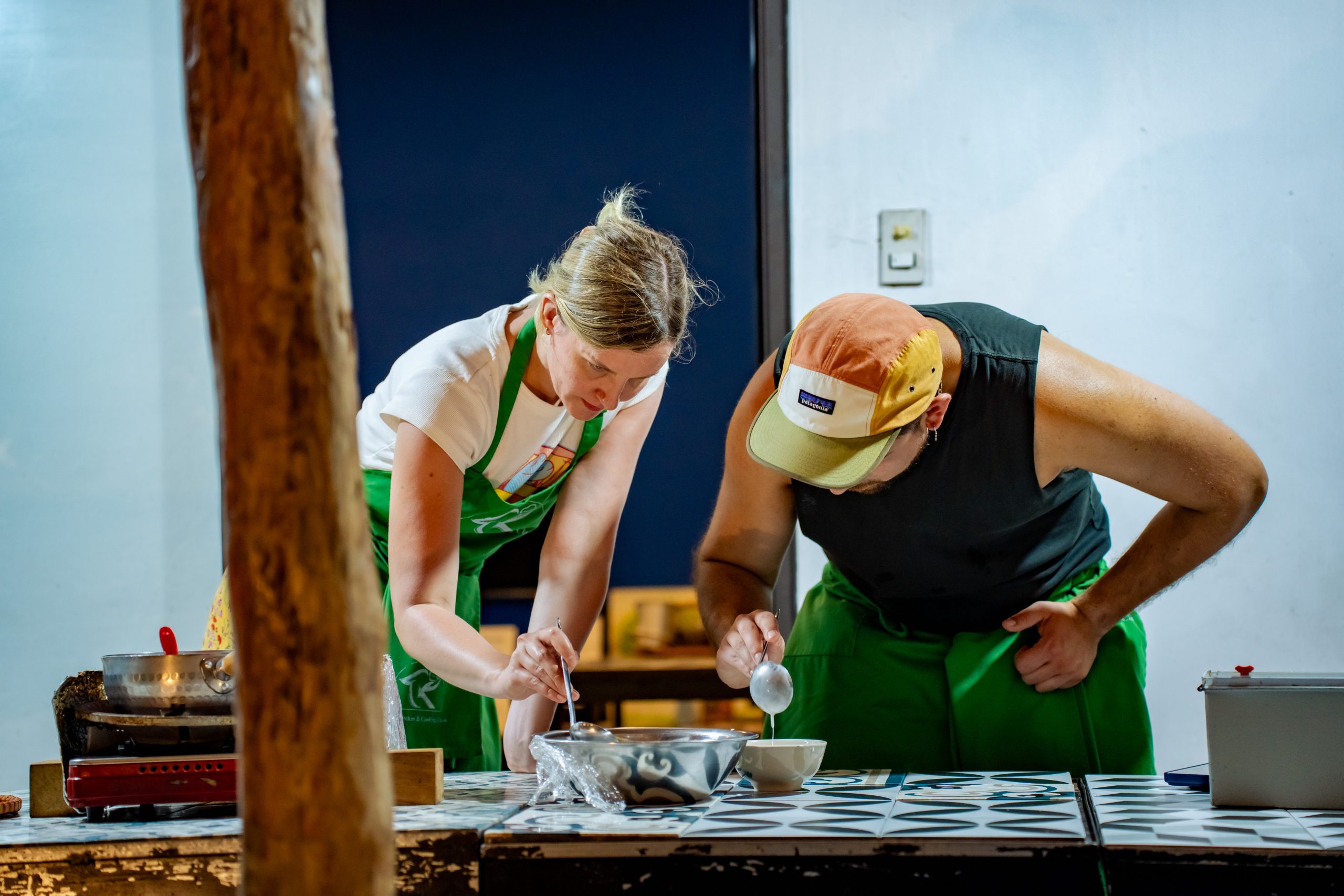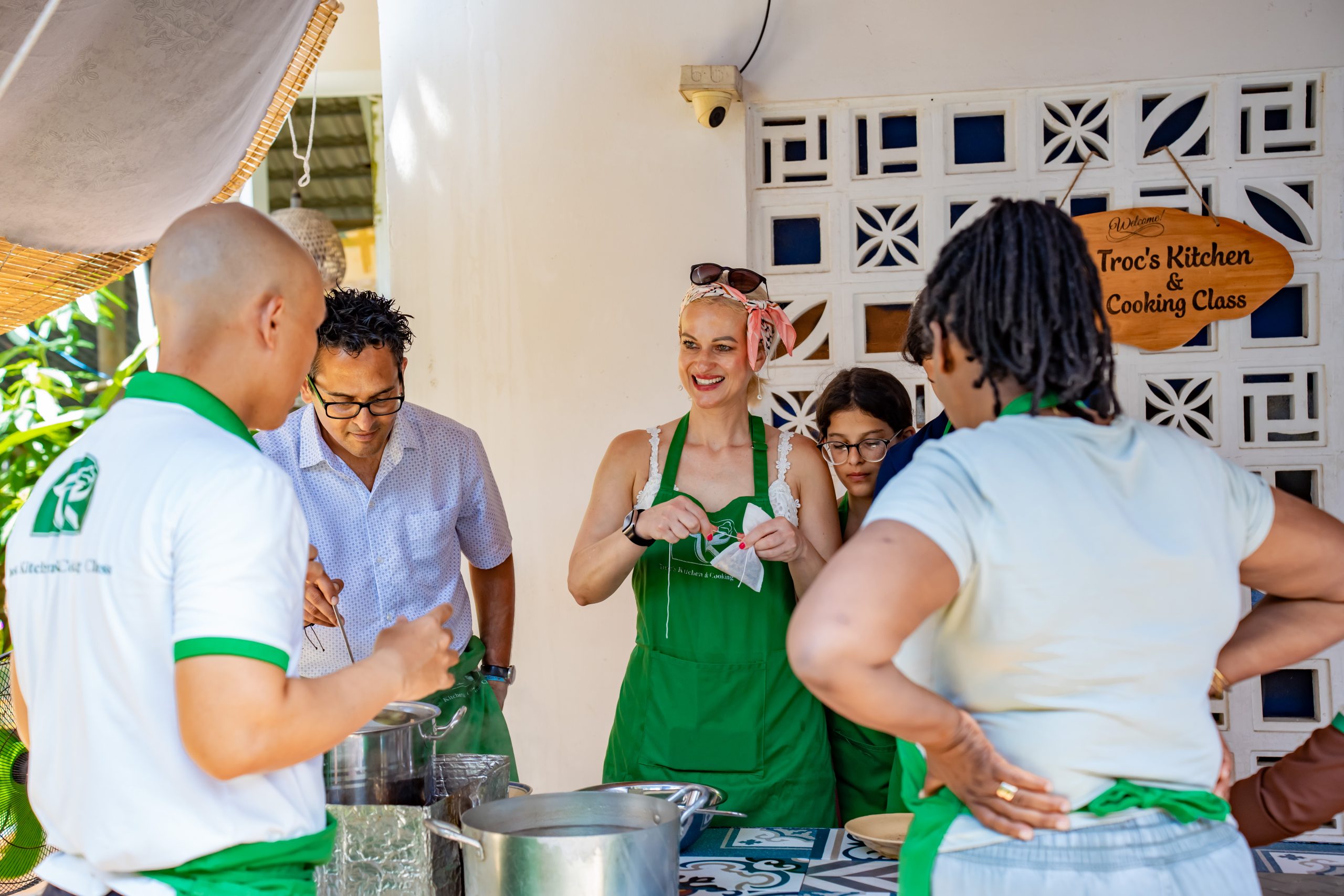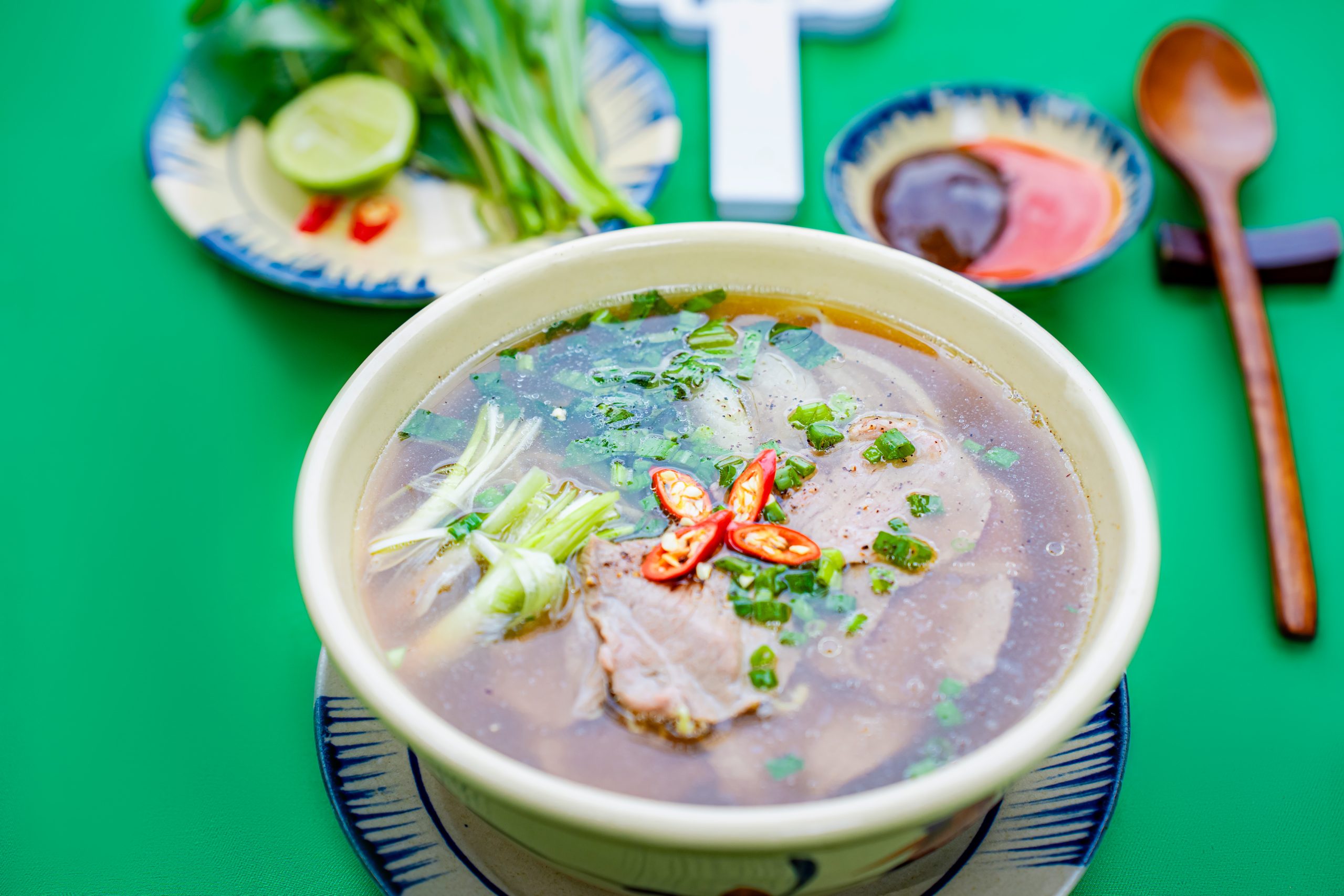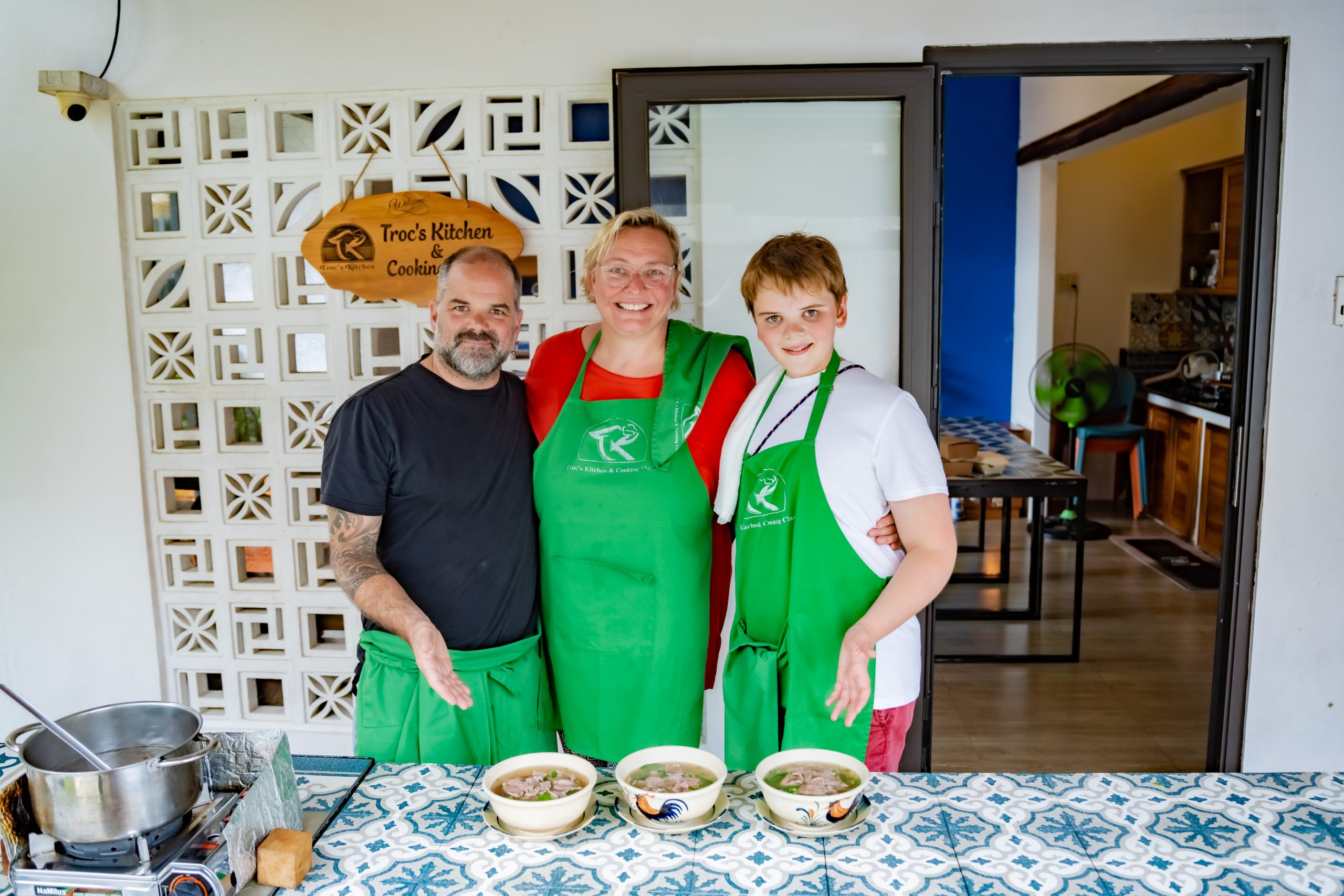Pho cooking class Phu Quoc

Pho cooking class Phu Quoc at Troc’s Kitchen
1.534.000 VND / 59 USD / 1 PAX
Vietnamese Pho cooking class Phu Quoc
- Starting time : 16 : 00 pm
- Duration : 3-4 hours
- Minimum participants : 2
- Maximum participants : 8
- Language : English and Chinese ( Mandarin ) ,Basic Korean
- Included highlights :
- all ingredients
- complimentary drink ( water , soft drinks or beer )
- cooking certificate
- intro to Vietnamese Cuisine
- learn from the professional Chef
- a small gift ( maybe the Chef will decide one extra dish for all the learners to hands-on ) during the time you do your Pho cooking class Phu Quoc with us .
- Schedule :
- 16 :00 pm : arrive at Troc’s Kitchen to ready for the Pho cooking class Phu Quoc island.
- 16 : 15 pm : an introduction with complimentary coffee or tea ( the learners will get the chance to share with our chef how to make the original Vietnamese dripping coffee . This coffee make by the filter .
- 16 : 45 pm : start to cook and taste the food course by course untill done on each menu option . Complimentary drink are available in you Pho cooking class Phu Quoc .
- 20 : 00 pm : Time to enjoy the fruit plate and receive certificate . End of the Pho cooking class Phu Quoc with Troc’s Kitchen.
- Menu :
- Main dish : Special Beef Pho
- Meeting point : meet at Troc’s Kitchen to do the Pho cooking class Phu Quoc .
- Confirmation : book now and receive your confirmation instantly . Would you please present your booking reference number at the cooking school.
- CONTACT US https://trocskitchenandcookingclass.com/contact-us/ to make your reservation our Pho cooking class Phu Quoc .

Above is a picture our guests are making Nem Nuong . They said that they know how to use Phu Quoc pepper and how is Duong Dong market after doing one of the cooking class with us . Follow us on Facebook page to view more information and promotion .https://www.facebook.com/Phuquoccookingclass.Trocskitchenandcookingclass
Beside the special main noodle soup Pho the learners also can get the chance to learn some more dishes during the time to wait for the special products ( main noodle broth is ready ).
What will you cook for the special Option Pho cooking class Phu Quoc ?
Vietnamese Traditional beef Pho ( Phở bò ).
During the time waiting for the broth of Pho you will learn three dishes below .
- Chả Giò (Vietnamese Deep-Fried Spring Rolls)
- Crispy spring rolls filled with a savory mixture of pork, shrimp, and vegetables.
- Bánh Xèo (Vietnamese Pancakes)
- Savory crispy pancakes filled with shrimp, pork, and bean sprouts, served with a delicious dipping sauce.
- Bánh Chuối Bọc Nếp Nướng (Grilled Banana Cake Wrapped in Sticky Rice Rolls)
- Sweet and savory banana cakes wrapped in sticky rice and grilled to perfection.often served with fresh coconut milk sauce .
What is Pho ?

ALL ABOUT PHO! EVERYTHING YOU NEED TO KNOW
While traditional Pho cuisine is simple in theory, one thing we are sure of. This flavourful noodle-based soup has far surpassed the street vendors of Vietnam and earned its spot alongside popular around the world cuisine.
Whether you are new to the world of Pho or it happens to be your all-time favorite meal, visit for the best Pho in Phu Quoc , Kien Giang Province made by yourself with our team of your Pho cooking class in Phu Quoc .
History of Pho
Dating back to the 19th and 20th centuries, Pho (pronounced ‘fuh’) is considered the national dish of Vietnamese culture. It is made traditionally with beef or chicken broth and seasoned with an array of flavors and herbs. In the Western world, chefs and popular Pho connoisseurs have taken a more creative spin on the traditional dish.
The term “pho” actually refers to the noodles used in the dish, and not the soup combination itself. While there are several variations of soup dishes in Vietnamese food culture, pho is the only one that incorporates pristine white-flour noodles. The quality of pho can be judged by the broth. A great bowl of pho will be clear as crystal and packed with a ton of flavor.
Types of Pho
When it comes to pho, there are two basic types – Pho ga (chicken) or Pho bo (beef). Condiments for both of these mouth-watering soups include hoisin and lime sauce, chili sauce, and a sweet and spicy sauce made from vinegar, garlic, sugar, and soybeans. All we will show you more in our Pho cooking class in Phu Quoc . In your Pho cooking class in Phu Quoc with us we will show you how to make the best and easiest way for the condiments but it still authentic and effective.
- Phở, pronounced “Pho,” is a Vietnamese soup that is normally made with a bone-beef broth, banh pho noodles, and thinly sliced beef, that’s often served with bean sprouts and other fresh herbs on the side. Not to be confused with Japanese ramen, which is usually made with wheat noodles, pho is made with rice noodles. It is important to note that there are many variations of pho. The most common is pho Nam , which originates in Southern Vietnam, and pho Bac, which is from Northern Vietnam and considered to be the original pho or Pho Sai Gon the South of Vietnam Pho .
- Pho bo (beef pho) is usually served with a large bowl of broth and rice noodles and is accompanied by a plate of thinly sliced raw beef and a plate of fresh garnishes like basil, cilantro, radishes, chilies, and lime.
- Pho Ga is generally more straightforward than pho bo. Chicken is added to the broth, along with bean sprouts, vegetables, scallions, basil, chili, and coriander.
- At most pho restaurants, there are also several condiments on the table, such as hoisin sauce, soy sauce, fish sauce, Sriracha, and chili paste, to flavor the broth. Essentially, each bowl of pho is unique to you. With many different add-ins, you are able to adjust the pho to your preference. I recommend starting with adding raw meat to your broth.
- After adding the meat, add fresh garnishes of your choice. I prefer adding the aromatic herbs first, such as basil and cilantro, to allow the flavor of the herbs infuse with the broth. Next, I add the garnishes that provide extra texture to the pho, such as bean sprouts, radishes, and chilies. To top it off, I add any sauces or lime to my dish. I like adding chili paste, hoisin sauce, and a squeeze of lime .
- Pho Health Benefits
- Pho is more than just a tasty, comforting, and delicious soup – it also has a range of surprising health benefits. Consider limiting the sodium and noodles, while topping your dish with more vegetables, for a filling and nutritious low-calorie meal.
- Just a single bowl of pho can contain up to 30g of protein, equalling half of the recommended amount for a healthy adult. The traditional Vietnamese dish has also been said to do the trick if you feel like you are coming down with a cold, similarly to the American version of chicken soup
- What Makes Pho Special?
- The broth is what making pho special, and a good pho depends first and foremost on the quality of the broth. It’s the difference between a bad homemade pho and a good pho, a normal pho restaurant and really good one. So, if one knows how to make a good broth, then everything else is just a matter of getting the pho ingredients from the markets.
- Pho is not pho without its broth, it’s the vital element that gives pho its life and soul. If you can enjoy the pho broth wholeheartedly, then the rest of the ingredients in the bowl will be enjoyable and you will want to slurp up to the last drops.
- Variations of Pho
- Not a fan of beef? No worries! There are multiple variations of pho. The most common variations are pho ga (chicken pho) and pho chay (vegetarian pho). It is important to note, however, that not all Vietnamese noodle soup dishes are considered pho. For example, Bún Bò Huế ( Huế beef noodle soup ) is a pork base broth with rice noodles from the Hue region of central Vietnam and Hủ Tiếu is a pork and seafood noodle soup that is common in Southern region of Vietnam. Although these other dishes may look similar to pho, they differ in their flavors and are not always served with banh pho noodles (flat rice noodles). You will get more information during your time with us on doing Pho cooking class in Phu Quoc . Please feel free to ask.
How long to complete for the Pho cooking class Phu Quoc ?
The Traditional Pho will take about at least 8-12 hours to cook for the broth can be full flavor . Contact us to arrange your Pho cooking class in Phu Quoc with the shortest time to learn how to cook pho https://trocskitchenandcookingclass.com/contacts-us/https://www.trocskitchen.com/contact-us to make the reservation of your Pho cooking class in Phu Quoc .
How Pho is Cook/ Pho cooking class Phu Quoc cook?
From the early days when Pho first came to life, beef bones are left to boil and simmer in water on low heat for at least three hours, the scum and foam formed by excess grease from the bone marrow are skimmed to discard.
The process that pho is cooked largely varies on the skill and dedication of the person cooking it. Most pho recipes have many common elements between them, from the ingredients that go into the broth to the length of time required in making it. Troc’s Kitchen and cooking class team will ensure that after doing our Pho cooking class in Phu Quoc with us you find it convenient to flexible yourself .
Chef Troc at Troc’s Kitchen calls for the following ingredients to prepare for the Pho cooking class in Phu Quoc : ginger, shallots, yellow onions, marrow-rich beef bones and beef knuckle bones, star anise, cinnamon, salt, fish sauce, yellow rock sugar/ regular sugar, cloves, cardamom, scallion, cilantro and fresh rice noodles. If you want to try and make pho yourself, here’s a generic process to cook (pho bo )and cook (pho ga )at home after doing Pho cooking class in Phu Quoc .
Where Do We Eat Pho?
Though pho is the most popular breakfast in Hanoi / Saigon/ Phu Quoc , people rarely cook pho at home. Instead, they go a traditional pho restaurant to have a good pho. Perhaps, the amount of time it takes to cook the pho broth is what turning people off from trying to cook Pho at home. After doing Pho cooking class in Phu Quoc with us you can do again at home for sure .
As many pho lovers already know, it takes at least three hours to simmer a standard broth. A good broth usually requires the beef bones to be boiled gently for six to eight hours, high quality traditional pho restaurants are known to simmer the beef bones up to 12 hours or more!
Why do we need to boil the bones for so long? It’s because it takes time for the marrow in the bones to dissolve into the broth. A hard boil will distort the flavors of the pho broth.
Policy regarding Refund & Cancellation
Class designated as Full Payment
Refund Deadline: Refunds are available up to 14 days before your class starts.
No Refunds Within 14 Days: If you cancel within 14 days of your class, we cannot provide a refund.
Class Exchange: You can exchange your class for another Troc’s Kitchen and cooking class. Refund Amount: Refunds are 50% of the total payment for your cooking class.
For individuals belonging to the deposit category
Troc’s Kitchen Refund and Exchange Policy
We understand that plans can change! Here’s a breakdown of our policy:
- Deposits: Unfortunately, deposits for your cooking class are non-refundable.
- Class Exchange: Within 30 days of booking, you can exchange your class for any other Troc’s Kitchen cooking class. This allows you to choose a different date or theme that better suits your schedule or interests.
Important: Class exchanges are only valid within the 30-day window.
To Exchange Your Class:
If you want to exchange your class for another available option, simply send an email to beptroccookingclass@gmail.com

